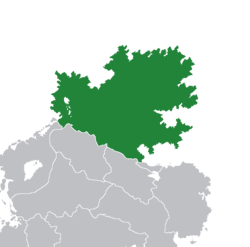Caledonia
This article is incomplete because it is pending further input from participants, or it is a work-in-progress by one author. Please comment on this article's talk page to share your input, comments and questions. Note: To contribute to this article, you may need to seek help from the author(s) of this page. |
Republic of Caledonia 5 other official names
| |||||||||||
|---|---|---|---|---|---|---|---|---|---|---|---|
|
Flag | |||||||||||
| Motto: "Ceartas, Aonachd, Neart" "Justice, Unity, Strength" | |||||||||||
 Map of Caledonia in Lorecia | |||||||||||
| Capital and | Baltyre | ||||||||||
| Official languages | Caledonian, Ryhull, Spámi, Nyorsk, Valkean | ||||||||||
| Demonym(s) | Caledonians | ||||||||||
| Government | Federal parliamentary republic | ||||||||||
• President | Peadair Lobhdain | ||||||||||
• Prìomh Mhinistear | Ainslie MacKinnel | ||||||||||
| Legislature | Pàrlamaid | ||||||||||
| Taigh Uarach | |||||||||||
| Taigh Iarach | |||||||||||
| Population | |||||||||||
• 2019 estimate | 36,562,120 | ||||||||||
• 2015 census | 33,410,345 | ||||||||||
| GDP (PPP) | 2020 estimate | ||||||||||
• Total | $1,672,000,000,000 | ||||||||||
• Per capita | $52,839 | ||||||||||
| GDP (nominal) | 2020 estimate | ||||||||||
• Total | $1,672,000,000,000 | ||||||||||
• Per capita | $52,839 | ||||||||||
| Gini (2020) | 29.3 low | ||||||||||
| HDI (2020) | 0.889 very high | ||||||||||
| Currency | Punt (PCA) | ||||||||||
Caledonia, officially the Republic of Caledonia (Caledonian: Poblachd Caledonia), is a federal republic located on northern Lorecia. It borders clockwise, Nynorsk Ostlijord, Artoszka, Plätteisen Adler, Western Tundra, Ostrothia and Valkea. Although it is one of the largest countries in the region by land area, most of the territory is practically uninhabited by its northern location,; most of the population is concentrated in the southern region, near the border with Valeka and Ostrothia and along the eastern coasts. Caledonia's capital city is Baltyre and other important metropolitan regions are [[_]], [[_]] and [[_]].
Caledonia traces its origins to the early duchies formed in the eastern gulf and southern regions. Valkean and Nynorsk influences forced the consolidation of Baltyre and the early formation of the Kingdom of Caledonia, which gradually expanded throughout the centuries across most of the north of Lorecia. Conflicts with Vikings arose during the 10th century, period in which Christianisation took place in most of the inhabited territory with the proclamation of someone as King of Caledonians. During he 16th century, unclear succession lines provoked a civil war between Caledonians and Ryhulls over the proclamation of the next king, which concluded with the territory's conversion to Protestantism and later, near the 17th century, the Kingdom of Caledonia would consolidate its territory and with the assumption of someone to the throne, the Empire of Caledonia was proclaimed with the start of the first colonial expeditions, which counted with a large presence on the south of Astyria. During the 18th century, an early industrialisation would commence around Baltyre and other important urban centres fuelled mainly by the presence of the railway. However, despite its land mass and population, the country would remain stagnated behind other industrial Lorecian powers like Noordenstaat and Valkea.
During the early 20th century, the country accelerated its industrialisation through a set of protectionist laws that restricted imports in favour of national produce. Measures rapidly caused diplomatic conflicts with surrounding nations like Aswick and Aquitayne and the country started a period of isolation, which proved effective to the monarchy as it countered the republican spirit that surrounded the Valkean Revolt of 1904. However, with the burst of the Great Astyrian War, Caledonia did not remain neutral and joined the Northern Powers on behalf of personal traties signed with other monarchies. The country would not remain in conflict until its end as financial shortages caused the expansion of social discontent against the monarchs. Protests, largely repressed would end with the withdrawal of the nation from the Great War and a series of concessions made by the monarch, which ultimately concluded with their exile and the proclamation of the Republic of Caledonia in 1924. The post-war period was characterised by political and economical stability; in the regional scenario, early governments adopted a special neutrality policy, which allowed Caledonia to expand its ties with Valkea's Kansalist governments and Lorecian liberal powers. Labour governments emphasised in large industrialisation processes and in the 1960s, the discovery of oil in the north of Caledonia helped the expansion and consolidation of an important welfare state.
Caledonia counts with one of the highest GDP per-capita of Lorecia and Astyria and usually ranks high in Human Development Index, press freedom and overall happiness. The country is a federal parliamentary republic as specified by its constitution, with a large degree of autonomy granted to its states. The President of Caledonia serves as the head of state while the Prime Minister as head of government; the bicameral legislature is composed by the Taigh Uarach and the Taigh Iarach. Caledonia is a member of the Vinstrian Union.


